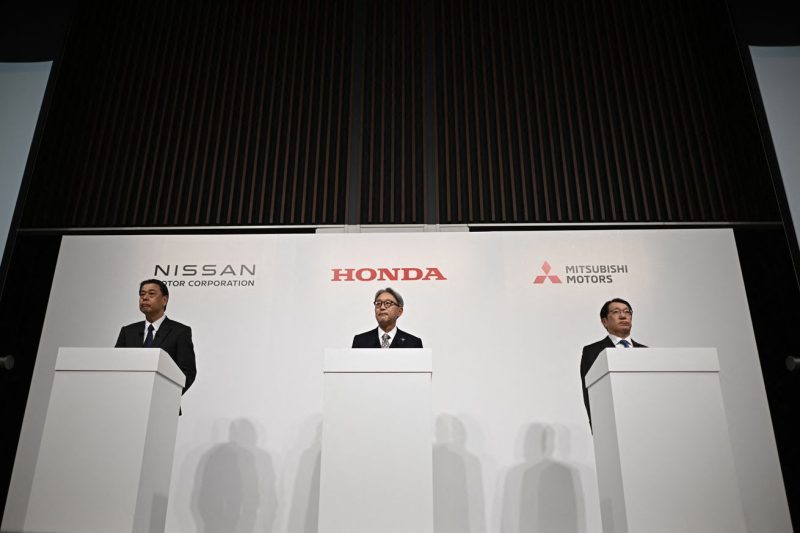Honda’s potential merger with Nissan would represent one of the largest shake-ups to the industry since the creation of Stellantis in 2021. But there are huge risks involved, too.
On Tuesday in Las Vegas, during a roundtable discussion with select media, Honda executives offered some more insight into the merger, including how combining resources and factories could help the companies stay competitive in the increasingly costly fight with China.
Honda is concerned about China’s meteoric rise as a dominant and highly competitive player in the EV and autonomous driving space. In late December, when Honda and Nissan announced that they had signed a memorandum of understanding to create an automotive company worth around $50 billion, Honda CEO Toshihiro Mibe said that the “rise of Chinese automakers and new players has changed the car industry quite a lot… We have to build up capabilities to fight with them by 2030, otherwise we’ll be beaten.”
The stakes are high, too. According to a recent report by S&P Global Mobility, the global EV market will grow nearly 30 percent year over year, with 89.6 million new EVs expected to be sold this year. According to Allied Market Research, the global autonomous vehicle market is expected to reach around $60.3 billion in 2025 and is projected to reach $448.6 billion by 2035. If the Japanese automakers want to continue to dominate the market as they have since the 1960s, they have to iterate quickly and get products into consumers’ hands.
“Since the beginning of last year, we’ve been in conversation with Nissan,” Noriya Kaihara, director and executive vice president at Honda, said through a translator following the company’s debut of two “production prototypes,” the Honda 0 Saloon and the Honda 0 SUV at CES. “Nothing has been decided but we’ve been discussing how to proceed.”
Photo: Vjeran Pavic / The VergeThe Honda 0 Saloon at CES.
Honda wants Nissan’s large SUVs and underutilized factories
During the roundtable, Kaihara said that Honda is looking at Nissan as a way to reduce costs around future software-defined vehicles (SDV).
“We have significant labor and development costs, and if there are operations we could share, that would be good for us,” he said. Developing brand-new software, he continued, including advanced driving systems that move closer to autonomous vehicles and battery-electric vehicles, is both increasingly important for the longevity of established automakers and increasingly expensive.
Honda also said that Nissan’s large SUVs like the Armada and Pathfinder make it an attractive partner. Toshihiro Akiwa, VP and head of Honda’s BEV development center, said through a translator that Honda’s hybrid technology is solid but only currently exists in its midsize vehicles like the CR-V and the Accord. The company is interested in Nissan’s larger vehicles because Honda’s “motor and battery capacity can be adapted to the larger vehicle.”
Image: HondaThe Honda Prologue.
Image: NissanThe Nissan Armada.
While Honda does have the Prologue, that vehicle was part of a $5 billion joint venture with GM that only lasted through the development of two vehicles. The Prologue has been a surprise EV hit, selling over 33,000 in 2024 and outselling the larger gas-powered Honda Passport.
Since the partnership with GM went south, it’s not likely that the Prologue will be in production long, though Honda has made no announcements about its plans for the vehicle. Honda does not currently offer an all-electric crossover outside of the Prologue, though fans of the brand have been asking for an all-electric CR-V for years.
Nissan, on the other hand, saw its earnings decline by as much as 90 percent last year, forcing it to lay off thousands of employees. The company has been struggling since the arrest of former Nissan CEO Carlos Ghosn in 2018 for financial misconduct. Unsurprisingly, Ghosn isn’t pleased about the news, telling Bloomberg that Nissan was in “panic mode,” calling the deal a “desperate move” and noting that the “synergies between the two companies are difficult to find.”
But as Honda executives at the roundtable noted, Nissan’s struggle could pose an opportunity for Honda, too. That’s because Honda plants that serve the US are currently running at maximum capacity, and they could use the excess capacity at Nissan’s factories to meet customer demand. “I’m not in a position to make comment [on Nissan], but they have capacity,” Kaihara said.
Photo by PETER POWER / AFP via Getty ImagesHonda’s factory in Ontario, Canada.
Trump’s tariff threats and loss of EV incentives
President-elect Donald Trump’s threats to impose tariffs on foreign imports and eliminate federal subsidies that have helped save Americans billions in EV costs also came up in the conversation. “If Trump impacts future government strategy we have to be very flexible when the subsidies are cut or stopped,” Kaihara said.
That includes where Honda builds and produces its most popular vehicles like the CR-V and Civic. “Each factory in Canada and Mexico is almost to full production level,” Kaihara said. “It’s not so easy to change that direction, but depending on the tariff situation, we might have to change the production location to Japan or somewhere else.”
A significant move like that would be costly and could translate to increased prices for consumers when they go to buy their next Honda.
In spite of all this, Honda is not wavering on its commitment to electrification. “For the time being, we will have new EVs in the next year for the Zero series,” Kaihara said. “For the long term, I think, considering the environmental issues, EVs will be the solution for the future, and that will not be changed.”

